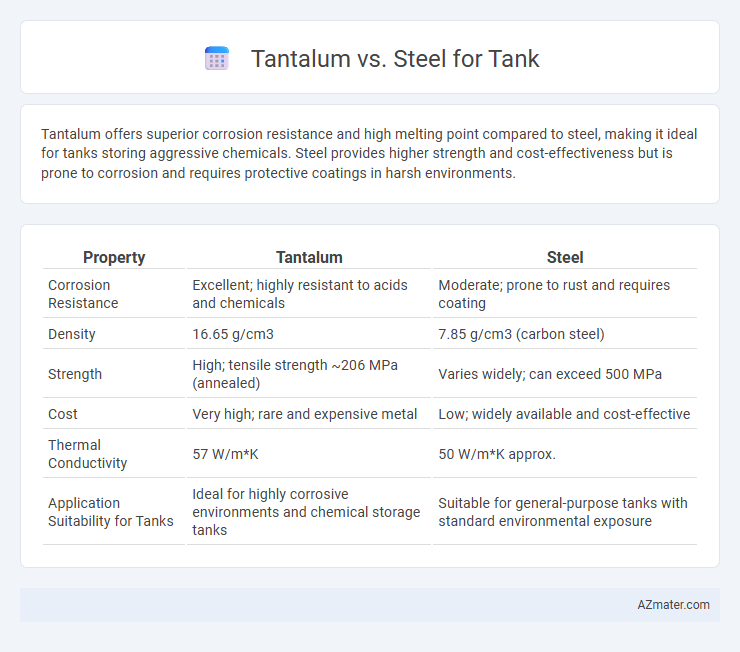Tantalum offers superior corrosion resistance and high melting point compared to steel, making it ideal for tanks storing aggressive chemicals. Steel provides higher strength and cost-effectiveness but is prone to corrosion and requires protective coatings in harsh environments.
Table of Comparison
| Property | Tantalum | Steel |
|---|---|---|
| Corrosion Resistance | Excellent; highly resistant to acids and chemicals | Moderate; prone to rust and requires coating |
| Density | 16.65 g/cm3 | 7.85 g/cm3 (carbon steel) |
| Strength | High; tensile strength ~206 MPa (annealed) | Varies widely; can exceed 500 MPa |
| Cost | Very high; rare and expensive metal | Low; widely available and cost-effective |
| Thermal Conductivity | 57 W/m*K | 50 W/m*K approx. |
| Application Suitability for Tanks | Ideal for highly corrosive environments and chemical storage tanks | Suitable for general-purpose tanks with standard environmental exposure |
Overview: Tantalum vs Steel in Tank Applications
Tantalum offers exceptional corrosion resistance and biocompatibility, making it ideal for tanks storing highly reactive or corrosive substances. Steel, commonly used for tank construction, provides superior mechanical strength and cost-effectiveness but may require coatings or linings to prevent corrosion in aggressive environments. The choice between tantalum and steel for tanks depends on balancing chemical resistance needs with budget and structural requirements.
Material Properties: Strength and Durability
Tantalum exhibits exceptional corrosion resistance and high melting point, making it ideal for tanks exposed to aggressive chemicals or extreme temperatures. Steel offers superior tensile strength and impact resistance, providing robust structural integrity for heavy-duty tank applications. The choice between tantalum and steel hinges on balancing chemical resistance with mechanical strength requirements.
Corrosion Resistance Comparison
Tantalum offers superior corrosion resistance compared to steel, especially in highly aggressive chemical environments such as acids and chloride-rich solutions. Its excellent resistance to pitting, crevice corrosion, and stress corrosion cracking makes tantalum ideal for tanks storing corrosive substances. Steel tanks require specialized coatings or liners to achieve similar durability, which may degrade over time, whereas tantalum maintains integrity without additional protection.
Chemical Compatibility and Reactivity
Tantalum exhibits exceptional chemical compatibility with highly corrosive substances such as hydrochloric acid and sulfuric acid, making it ideal for tanks handling aggressive chemicals. Steel, particularly carbon or stainless steel, is prone to corrosion and chemical reactions when exposed to strong acids or alkaline solutions, limiting its use in highly reactive environments. The superior corrosion resistance and inertness of tantalum ensure minimal reactivity, extending tank lifespan and reliability compared to steel in chemically aggressive applications.
Cost Analysis: Tantalum vs Steel
Tantalum tanks exhibit higher upfront costs due to the metal's scarcity and complex manufacturing processes, often exceeding steel tank costs by two to three times. Steel tanks offer lower initial investment and widespread availability, making them cost-effective for large-scale storage despite shorter lifespan under corrosive conditions. Long-term expenses for tantalum tanks can be lower when considering reduced maintenance and replacement costs in highly corrosive environments.
Weight and Density Considerations
Tantalum has a density of approximately 16.6 g/cm3, which is significantly higher than steel's density, typically around 7.85 g/cm3, resulting in much heavier tanks when using tantalum. The weight of a tank constructed from tantalum can be over twice that of a steel tank of the same volume, impacting transport and structural support requirements. Despite the weight drawback, tantalum's superior corrosion resistance and strength-to-weight ratio may justify its use in specialized applications where durability outweighs the need for lightness.
Fabrication and Welding Challenges
Tantalum offers superior corrosion resistance compared to steel, making it ideal for tanks handling aggressive chemicals, but its fabrication and welding require specialized techniques due to its high melting point and reactivity with oxygen. Steel is easier to fabricate and weld using conventional methods, with well-established procedures and lower costs, but it may require protective coatings to prevent corrosion in harsh environments. Welding tantalum demands inert gas shielding and strict contamination control to avoid embrittlement and maintain mechanical integrity, whereas steel welding is more tolerant to environmental exposure and simpler to perform.
Maintenance and Longevity
Tantalum tanks exhibit exceptional corrosion resistance and require minimal maintenance compared to steel tanks, which often demand regular inspections and treatments to prevent rust and degradation. The inherent chemical stability of tantalum ensures extended longevity in harsh environments, significantly outlasting steel alternatives prone to wear and corrosion over time. Maintenance costs for tantalum tanks are substantially lower, resulting in improved lifecycle performance and reduced downtime.
Industry Applications and Standards
Tantalum offers exceptional corrosion resistance and high-temperature stability, making it ideal for chemical processing tanks handling aggressive acids and oxidizing environments where steel tanks may fail due to corrosion. Steel tanks, especially those made from stainless steel grades like 304 and 316, are widely used in industries such as oil and gas, water treatment, and food processing due to their strength, cost-effectiveness, and compliance with industry standards like ASTM A240 and ASME Boiler and Pressure Vessel Code. The choice between tantalum and steel tanks depends on application-specific factors including chemical compatibility, temperature conditions, and adherence to regulatory standards such as ASME, ASTM, and ISO certifications.
Environmental and Safety Impacts
Tantalum tanks exhibit superior corrosion resistance, reducing the risk of hazardous leaks and environmental contamination compared to steel tanks, which are prone to rusting and structural degradation. The inert nature of tantalum minimizes chemical reactions, enhancing safety in storing aggressive substances, while steel tanks may require additional coatings and maintenance to prevent hazardous failures. Tantalum's recyclability and longer lifespan contribute to a lower environmental footprint, whereas steel production and frequent replacements increase resource consumption and waste generation.

Infographic: Tantalum vs Steel for Tank
 azmater.com
azmater.com